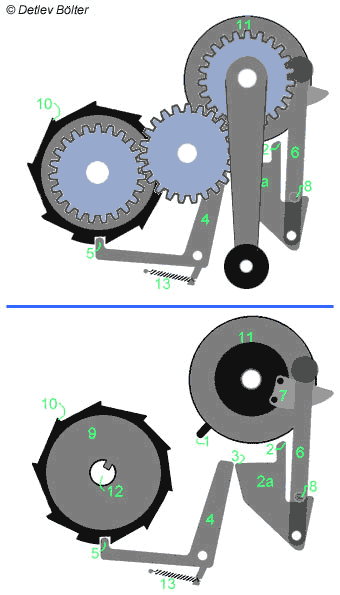 (Explanations in english by Nicholas Bodley, USA and Herbert Schneemann )
(Explanations in english by Nicholas Bodley, USA and Herbert Schneemann )This mechanism adds and multiplies; it does not reverse to subtract. However, rotating the crank backwards clears the result dials.
The design is unique, even surprising. Referring to the illustration, the input wheel [11] as well as the result-dial shaft are driven directly by the handcrank (picture above). The picture below shows the mechanism without crank and driving wheels.
This gearing operates all the time, so that the two shafts always rotate together. The result dials, which always move with ratchet [10], are driven by slip clutches; this means that if they remain at zero, the crank torque is much greater than if you add, say, all nines to all zeros. As shown, the result dial is at zero.
Slip-clutch disc [9] is keyed [12] to the result-dial shaft. Clutch friction rotates the result dial (attached to ratchet [10]), but only if lever [4] and dog [5] do not block its motion. However, if lever [4] blocks rotation of ratchet [10], then disc 9 slips on [10], allowing the gears and handcrank to continue turning. In this case, the handcrank needs more torque to turn it. This also means that the dials cannot overshoot if one cranks fast.
(Unlike many ratchets, there is no pawl that moves back and forth to advance this ratchet, only a slip clutch. In this mechanism, the ratchet stalls at the proper time in one direction, and (mostly) rotates freely in the other direction.)
A single tooth [1] extends from wheel [11], but its angular position relative to fixed cam [7] changes according to the number entered into this digit. It retracts if you enter a zero.
When you rotate the handcrank forward (clockwise), the tooth [1] will contact the projection [2] on rocker arm [2a]. That arm pushes arresting lever [4] at point [3] to release ratchet 10, allowing [10] to be turned by clutch disc [9]. Larger numbers make this release happen sooner in the cycle, so that the number wheel rotates farther in this case. All number wheels stall at the same time.
Near the end of the cycle, the curved edge of cam [7], operating through lever [6] and pin [8], restores rocker arm [2a] to its home position. Spring [13] ensures that the rocker arm will make dog [5] stall a ratchet tooth and leave the number wheel in the correct position.
Note that if a zero is entered, tooth [1] is retracted, so rocker arm [2a] stays at home position, and ratchet [10] keeps the dial from moving at all. The slip clutch slips, and the handcrank feels slightly stiffer.
When the cycle is complete, dog [5] blocks all ratchets, but at positions that depend upon the numbers displayed. Any of the teeth of the ratchet can catch on dog [5] when the cycle is complete, so the square notch can be in any of ten positions.
Carries happen when a number wheel starts to move from [9] to [0]. A projection on the number wheel trips a carry lever (these are not shown in this diagram; see the last photo, below). This carry lever releases dog [5] for the result wheel to the left, so that its slip clutch can rotate it by one count. The carry happens at the same time this number wheel moves from nine to zero.
Carry levers are reset by a pin on the number wheel, located between digits 5 and 6.
To summarize, the result dials are stalled at first. As the cycle continues, tooth [1] releases the ratchet at some point in the cycle, letting the result dials advance. At the end of the cycle, all result dials are stalled again. Adding a larger digit to the result means that the dial for that digit is released earlier.
[Clearing]
To clear the result, you turn the crank backward (counterclockwise). Any wheels that are not at zero were stalled by the ratchet teeth, but not by the square notch at [5] in the illustration. Those wheels not at zero rotate, raising dog [5] by each ratchet tooth as they turn, until the square notch lets dog [5] rise and lock the ratchet against further movement. The slip clutch then allows the number wheel shaft to finish the cycle.
The "wide tooth" on the ratchet, shown just to the left of the square notch, simply ensures that the dog, once it rises into the notch, will not be cammed downward during clearing by a sloping surface like that for the other nine digits.
Please see the other pictures, too!